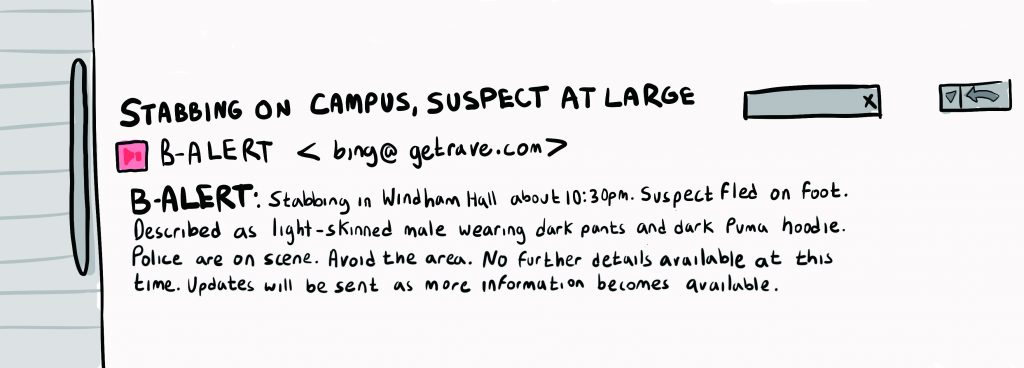On Sunday, April 15 at approximately 10:30 p.m., Binghamton’s New York State University Police (UPD) responded to a call that someone had been stabbed in Windham Hall of Mountainview College, propelling many students across campus to spread the word about what happened — well before Binghamton University even sent out the initial B-Alert to students at 11:14 p.m.
Before the B-Alert was sent out, numerous students across campus were frantically texting and calling their friends to alert them of the situation and to ensure their safety. Mountainview College residents were reportedly yelling out their bedroom windows to communicate with residents in neighboring buildings about what had occurred. It became quickly evident that the student body was faster at conveying the few details available than the University. Students alerted each other within minutes, while the administration took almost an hour to report the incident.
In the 45 minutes it took for the University to officially report the attack, rumors repeatedly circulated among students. No one was sure of the exact nature of the events that had taken place, where the safest spots on campus were, which specific areas to avoid or what the next steps should be. With inflated information and rumors spreading, students were sent into a wave of panic and fear.
On Monday morning, the University continued to send out B-Alerts, but it did not effectively help students to navigate the situation. At 6:16 a.m., we were alerted that the victim had died from his wounds. At 7:53 a.m., the University announced that classes would be canceled — less than 10 minutes before 8 a.m. classes were set to begin. Many students reported arriving on campus for their first classes of the day before the University announced the cancellation, even if they were unsure of whether the campus was secure or not. In the past, the University has announced snow day cancellations earlier than it did in this instance. In the case of Sunday night’s events, the administration’s failure to send out alerts in a timely manner impeded students’ abilities to stay safe and prompted some off-campus students to pointlessly arrive on campus the following day.
As of Monday morning, the suspect had not yet been taken into custody and the entire campus community was grieving and frightened. Yet, the University did not provide further instructions to students. Students living on campus didn’t know whether or not it was safe to go outside, whether the suspect was still at large and potentially dangerous and how to conduct themselves throughout the day. Although the administration gave out information at various press conferences during the day, officials never gave specific instructions, causing students more confusion and uneasiness. The University should have provided instructions and reassurance directly to students on Monday to aid students in navigating the aftermath of the tragedy.
The Editorial Board believes that there remain unanswered questions about how the suspect was able to re-enter his own dorm and how long he stayed there before his arrest, potentially endangering his roommates and other people around him.
The Editorial Board further asserts that the University’s failure to send out information in a timely manner after the attack and to provide additional instructions is unacceptable. It should go without saying that when a dangerous situation occurs on campus, students should be immediately informed. While we acknowledge and appreciate that the University wants to ensure that any information it dispenses is accurate, the lack of information about the incident bred misinformation, which caused increased panic among students. The University’s first priority should have been to send the correct safety information as quickly and efficiently as possible.
This isn’t the first time the Editorial Board has criticized the University’s emergency alert system. In a January editorial, we discussed the time delay between incidents and alerts, even for situations that were not as dire as Sunday’s events. We mentioned that the University should make it mandatory for students to sign up for B-Alert text messages, and this of course still stands, especially in the wake of this tragedy. Not only should the University send out alerts as quickly as possible, but all students should be signed up to receive text messages so that no one is left in the dark or put in danger.
In the final press conference held on Monday at 5 p.m., University President Harvey Stenger said: “We are going to go over the last 20 hours, everything that happened, everything that we did, how we communicated with our population, with our community and see if there are ways we could’ve done it better. You kind of learn on the fly with these things, and we want to make sure that if anything could have been done better, especially with the communication with our community, we learn from that.”
The Editorial Board acknowledges the complexities of informing a student body of transpiring, potentially dangerous events in a quick and efficient manner. But it is a responsibility that the University and UPD must adapt to in today’s climate. We sincerely hope that Stenger and the rest of the administration keeps their word.



